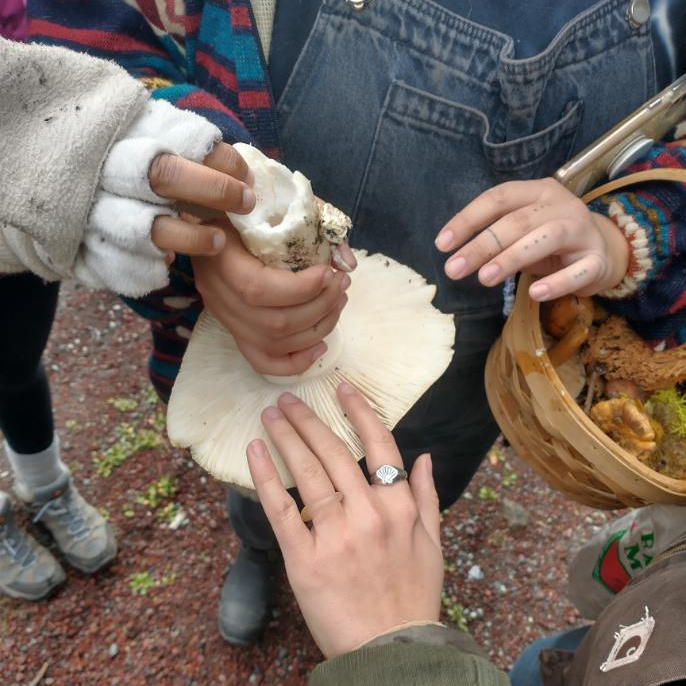September 27th | 12:00 - 2:00 PST
What can peer-to-peer learning models teach us about liberation and belonging?
Learning from “each other” is radical. It proposes that we don’t need “curriculum,” “teachers,” “standards,” or “testing” for learning - but rather, supportive structures that allow us to learn from one another. It’s an explicit rejection of individualism, competition and hierarchy, and is an expression of trust.
In this session, we’ll learn from organizations that are leaning into the power of peer-to-peer learning as we consider its potential, its challenges, and the conditions that make it possible.
Register below with a sponsorship code or via sliding scale pricing that begins at $25. Note, the sliding scale is an intentional effort to make inspiration as accessible as possible and to distribute resources equitably between organizations we work with.
Field trip guests
-

Alder Commons
Portland, Oregon
Alder Commons is a nonprofit community space where kids and adults alike can attend workshops and classes, and spend their time freely. Members include coworkers, artists, organizations, families, and self-directed learners of all ages. Its goal is to foster a multigenerational, multicultural community that practices and promotes its core values.
-

Liberated Kids
Oakland, California
Liberated Kids is a Self-Directed Education (SDE) Community for kids between the ages of 5-14 in Oakland. It is an alternative to school where kids are recognized as the leaders of their own learning. It is a safe space where Black, Indigenous, Latinx, and other POC voices and experiences are centered. It is rooted in community, as parents, family, and community members are guides and co-learners.
-

EdCamp
National
Edcamp is a radical - and yet simple - model for professional learning. Edcamps are free public events that leverage the knowledge and experiences of attendees by allowing educators to collaboratively determine topics for discussion the day of the event. Educators facilitate sessions by using their experiences to drive conversation with their peers. Educators are encouraged to find Edcamp sessions that best meet their needs to maximize learning.
-

The BRIDGE program
Tacoma, Washington
Implemented in three full-inclusion high schools (SAMI, SOTA and IDEA), BRIDGE is “near-peer” support program: It prepares young people with a uniquely identified skill within a particular area to offer specific support for other young people who need additional help in that area. It is common for a student to need the support of a bridge in one class and provide support as a bridge in a different class. The bridge program is built on an asset-based model of targeted support as opposed to a deficit-based model.
Syllabus
-
Recommended by both Alder Commons and Liberated Kids: “A leading expert in childhood development makes the case for why self-directed learning – "unschooling" – is the best way to get kids to learn. Peter Gray argues that in order to foster children who will thrive in today’s constantly changing world, we must entrust them to steer their own learning and development. Drawing on evidence and research, he demonstrates that free play is the primary means by which children learn to control their lives, solve problems, get along with peers, and become emotionally resilient.
https://www.amazon.com/Free-Learn-Unleashing-Instinct-Self-Reliant/dp/0465025994
-
“The Imaginary School is a place for us to study our world, and begin to think and practice ways that we might make it better. We hope that the Imaginary School can help us expand this imagination, help us ask better questions, help us see connections where once we saw borders, boundaries and walls.”
-
“Project Row Houses is a community platform that enriches lives through art with an emphasis on cultural identity and its impact on the urban landscape. We engage neighbors, artists, and enterprises in collective creative action to help materialize sustainable opportunities in marginalized communities.
Project Row Houses occupies a significant footprint in Houston’s Historic Third Ward, one of the city’s oldest African-American neighborhoods. The site encompasses five city blocks and houses 39 structures that serve as a home base to a variety of community-enriching initiatives, art programs, and neighborhood development activities.”
-
-
-
Get your wheels turning about this month’s theme. Want to share a resource to add here? Email info@theinspirationproject.org
ARTIST SPOTLIGHT
Participants will receive a unique postcard featuring art by Shavon Morris that responds to this month’s theme: Each Other.
Movement of a People visually depicts the strength and resilience of innovative educators as they work together through joint efforts, to radically move and shift schools. It symbolizes a collective dance, where all parts function together in unison, creating beauty together. Metaphorically speaking, some parts of the human body that seem weakest and least important are actually the most necessary. This piece ultimately explores the deep connection, and need we have for each other. How can we become more dependent? What can learning in community with each other teach us about liberation, purpose and belonging?
shavon morris
ABOUT THE ARTIST:
Shavon Morris is an artist and protector of culture interested in creative placemaking and architectural reclaim. Recently, she has begun investigating the true meaning of home and the effects of wealth disparity among Black populations in the South. Morris uses visual art and social practice to create conversations around preserving community identity.
In January of 2021, Morris completed an Artist Residency with The Printing Museum Houston and then exhibited in "Craft as a Tool for Activism" with The San Francisco Museum of Craft and Design. She was also recognized as an emerging artist with American Craft Council, worked with the City of Houston's: Department of Neighborhoods, and was named a 2021 Suzanne Deal Booth Fellow. The fellowship was a joint program with Project Row Houses and The Center for Art & Social Engagement that brought together artists, urban planners, and policymakers to engage in creative collaborations that involve the Third Ward Community.




